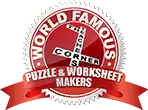 The Teacher's Corner
The Teacher's CornerPuzzles and Activities
Salt Dough Made Somewhat Better
STEP 1
Give students:
- blacklines of a US physical map
- atlases
- moldable clay (the kind that never dries out)
- Have large relief map or globe available if possible.
Review/define/model physical land features:
mountains, deserts, valleys, rivers, lakes, canyons, coastline, bay and so on
Teach children how to read physical maps: have them identify major landmarks on US: Great Lakes; Great Salt Lake; Mississippi/Missouri River; largest mountains. Compare heights of mountain ranges: Appalachia/ Allegheny; Sierra Nevadas; Rockies.
Students use modeling clay to build 3-D map. This is their sloppy copy.
Process: Talk with them about what worked, what didn't, what they'd do differently
STEP 2: Salt Dough Maps
1 part salt
2 parts flour
water to make dough
1-2T oil to keep from sticking to hands
Knead 5 minutes. Bake at 325-350 degrees for 30 minutes.
Children are given new blackline master, preferably larger version (11x17). Build the country or continent layer by layer. Show formation of mountains by squishing "plates" of salt dough together to crimp up mountains. Do Appalachians first, Sierras 2nd and Rockies 3rd. Pat down Appalachians to show erosion over time. Carve in the rivers and lakes. Bake @ 325 degrees for 30 minutes. Students paint using atlases as references. Students add legend/key. YES, THIS TAKES A LOT OF STORAGE SPACE.
Step 3: Optional
Make a very large salt dough map with kids. Project an outline on the wall using overhead to blow up map. Each cooperative group makes a region (NE, Eastern Seaboard, South, SW, NW, Great Plains, Alaska/Hawaii).
USING THE MAPS: You now have a supply of 3D maps that you can use to teach more concepts throughout the year:
1.Have students use the map and repaint to represent Native Tribal nations, and their dislocation leading eventual locations of reservations.
2.location of battles during Civil War
3.Location of tornadoes
4.Location of hurricanes
5. Geography/Agriculture
Submitted by: Lili Malabed karlita@email-removed